A Carpet of Sedum
October 12th, 2021
I don’t normally buy plants at box stores, but back in the spring when I was walking through the nursery at Lowe’s, a display caught my eye.
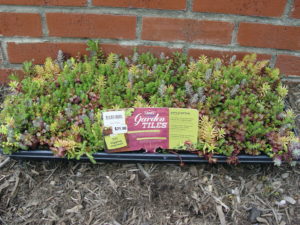
Garden Tiles trays look like this, priced at $21.98.
Colorful trays of mixed creeping sedum varieties were stacked on an end cap with tags reading, “Garden Tiles.”
I’d seen this idea – sometimes called “sedum carpet” – in a few garden centers and catalogs lately, too, so I decided to give a tray a try.
The sedums were growing in standard-sized, 10-by-20-inch, hard-plastic black trays but ones that were unusually shallow – only about an inch deep.
The mix had at least five different varieties of creeping sedum – some golden and ferny (‘Angelina?’), some more succulent and blue-tinted, and some with pinky-nail-sized green and/or burgundy-tinted foliage.
The label said the plants were growing in an inch-thick coco-fiber mat and could be planted as one whole, 10-by-20-inch carpet or torn apart into five-inch pieces and planted separately.
Figuring these were going to spread quickly, I decided to go with the tear-apart option.
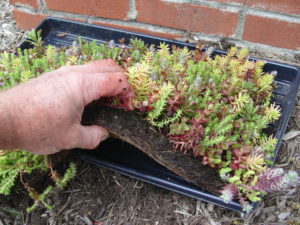
The mats are only an inch thick.
I used a garden knife to slice the mat into eight, five-by-five-inch pieces, then pressed the pieces 10 inches apart in front of my mailbox and in the front of a roadside rock garden.
At a cost of $21.98, getting eight good-sized clumps of creeping sedum is a good price – especially if all or most of the varieties are perennial types. I think they are – from the looks of them and from the indication that the plants were grown by Corso’s Perennials of Sandusky, Ohio – but the label doesn’t specify hardiness zone.
The label did say, “No digging required,” but also mentioned that planting into “loose” or “recently tilled” soil gives the best results.
I loosened my soil a few inches, pressed the pieces into the surface, firmed around the edges, and gave the plants a good watering.
Then I left them to fend for themselves – watering just twice over the summer when the weather got hot and dry for more than a week.
I’ve been impressed at how well these “Tiles” have done so far with almost no care.
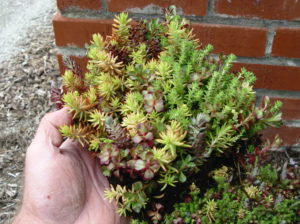
I planted five-inch pieces like these.
For one thing, deer haven’t touched them as with some other creeping sedums I have elsewhere in the yard (not to mention lots of other plants that aren’t even high on their dinner menu).
Second, the sedum pieces filled in those 10-inch gaps within a matter of weeks, giving more than twice the plant coverage that I started with out of the tray.
The plants remained full, healthy, and colorful all growing season with no bugs, no disease, no fertilizer, and not even any of the floppiness or “rattiness” that I’ve seen from some of the larger varieties of creeping sedum.
They’re still looking great, and one of the varieties has been blooming white for weeks.
The tiles grew densely enough that I didn’t even run into weed issues, save for an isolated oxalis or two that popped up while the gaps were filling in.
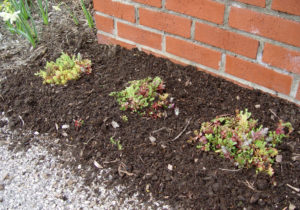
Garden Tiles at planting in May.
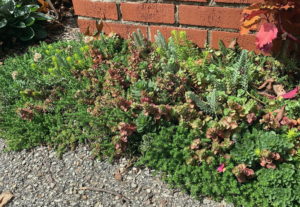
Garden Tiles at the end of September.
So far, Sedum Tiles seem to me to be an excellent way to cover a lot of bare ground in a short time at a good price.
The winter will be a key test to see how well the plantings come back.
Sometimes cold, wet winter soil takes a toll on succulents and other dry-soil-preferring species, even when plants are tough enough to withstand cold air temperatures.
Mine are planted in well drained, sunny locations, so that shouldn’t be an issue. I’d suggest avoiding soggy, low-lying, shady, and/or other poorly draining locations.
Assuming all goes well, I should be able to dig and divide my living carpet already next spring into even more pieces – expanding the flock and further up-valuing my investment.
I like the thought of that a lot more than replacing dead plants left behind by my furry, four-legged neighbors.







